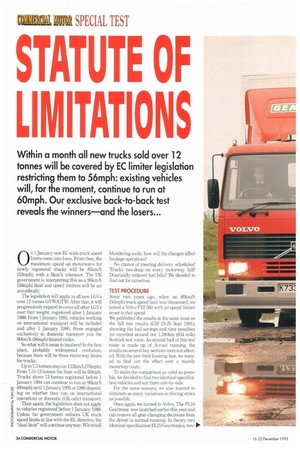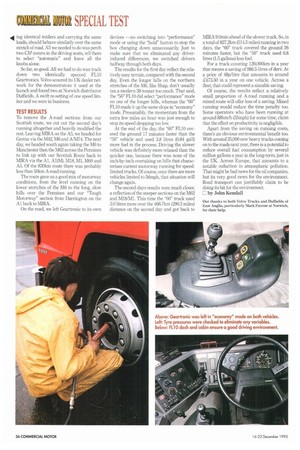STATUTE OF LIMITATIONS
Page 36

Page 38

If you've noticed an error in this article please click here to report it so we can fix it.
Within a month all new trucks sold over 12 tonnes will be covered by EC limiter legislation restricting them to 56mph: existing vehicles will, for the moment, continue to run at 60mph. Our exclusive back-to-back test reveals the winners—and the losers...
0 n 1 January new EC-wide truck speed limits come into force. From then, the maximum speed on motorways for newly registered trucks will be 85km/h (53mph), with a 5km/h tolerance. The UK government is interpreting this as a 90km/h (56mph) limit and speed limiters will be set accordingly.
The legislation will apply to all new LGVs over 12 tonnes GVW/GTW. After that, it will progressively expand to cover all other LGVs over that weight, registered after 1 January 1988. From 1 January 1995, vehicles working on international transport will be included and after 1 January 1996, those engaged exclusively in domestic transport join the 901(m/h (56mph) limited ranks.
So what will it mean to hauliers? In the first place, probably widespread confusion, because there will be three motorway limits for trucks.
Up to 7.5 tonnes stays at 112km/h (70mph). From 7.51-12 tonnes the limit will be 60mplt Trucks above 12 tonnes registered before 1 January 1994 can continue to run at 961cm/h LA (60mph) until 1 January 1995 or 1996 depend 1 ing on whether they run on international
■ 2 operations or domestic (UK only) transport. -.1.. Then again, the legislation does not apply ito vehicles registered before 1 January 1988. szUnless the government reduces UK truck ig speed limits in line with the EC directive, the 1 "dual limit" will continue anyway. Whitehall
blundering aside, how will the changes affect haulage operations?
No chance of meeting delivery schedules? Trucks two-deep on every motorway hill? Drastically reduced fuel bills? We decided to find out for ourselves.
TEST PROCEDURE Some two years ago, when an 80km/h (50mph) truck speed limit was threatened, we tested a Volvo F12 360 with its speed limiter re-set to that speed.
We published the results in the same issue as the full test results (CM 19-25 Sept 1991), showing the fuel savings and time penalties we recorded around our 1,180km (834 mile) Scottish test route. As around half of this test route is made up of A-road running, the results on several key sections were not affected. With the new limit looming fast, we wanted to find out the effect over a mainly motorway route.
To make the comparison as valid as possible, we decided to find two identical specification vehicles and test them side-by-side.
For the same reasons, we also wanted to eliminate as many variations in driving styles as possible.
Once again we turned to Volvo. The ELIO Geartronic was launched earlier this year and can remove all gear-changing decisions from the driver in normal running. In theory, two identical specification FL10 Geartronics, tow110'
ing identical trailers and carrying the same loads, should behave similarly over the same stretch of road. All we needed to do was perch two CM testers in the driving seats, tell them to select "automatic" and leave all the knobs alone.
So far, so good. All we had to do was track down two identically speccal FL10 Geartronics. Volvo scoured its UK dealer network for the demonstrators it used at the launch and found two at Norwich distributor DuffleIds. A swift re-setting of one speed limiter and we were in business.
TEST RESULTS To remove the A-road sections from our Scottish route, we cut out the second day's running altogether and heavily modified the rest. Leaving MIRA on the A5, we headed for Gretna via the M42, M6 and A/M74. The next day, we headed south again taking the M6 to Manchester then the M62 across the Pennines to link up with our Scottish Route back to MIRA via the Al, Al(M), M18, Ml, M69 and AS. Of the 830km route there was probably less than 50km A-road running.
The route gave us a good mix of motorway conditions, from the level running on the lower stretches of the M6 to the long, slow hills over the Pennines and our "Tough Motorway" section from Darrington on the Al back to MIRA.
On the road, we left Geartronic to its own devices —no switching into "performance" mode or using the "hold" button to stop the box changing down unnecessarily. Just to make sure that we eliminated any driverinduced differences, we switched drivers halfway through both days.
The results for the first day reflect the relatively easy terrain, compared with the second day. Even the longer hills on the northern stretches of the M6, like Shap, don't usually tax a modern 38-tonner too much. That said, the "56" FL10 did select "performance" mode on one of the longer hills, whereas the "60" FL10 made it up the same slope in "economy" mode. Presumably, the momentum from the extra few miles an hour was just enough to stop its speed dropping too low.
At the end of the day, the "60" FL10 covered the ground 17 minutes faster than the "56" vehicle and used 3.8 litres (0.84 gall) more fuel in the process. Driving the slower vehicle was definitely more relaxed than the quicker one, because there was none of the inch-by-inch overtaking on hills that characterises current motorway running for speedlimited trucks. Of course, once there are more vehicles limited to 56mph, that situation will change again.
The second days results were much closer, a reflection of the steeper sections on the M62 and M18/M1. This time the "60" truck used 3.0 litres more over the 466.7km (290.3 miles) distance on the second day and got back to
MIRA 9.0min ahead of the slower truck. So, in a total of 827.2km (514.5 miles) running in two days, the "60" truck covered the ground 26 minutes faster, but the "56" truck used 6.8 litres (1.5 gallons) less fuel.
For a truck covering 120,000km in a year that means a saving of 986.5 litres of derv. At a price of 48p/litre that amounts to around £473.50 in a year on one vehicle. Across a fleet, that could represent a sizeable saving.
Of course, the results reflect a relatively small proportion of A-road running and a mixed route will offer less of a saving. Mixed running would reduce the time penalty too. Some operators who have been running at around 88km/h (55mph) for some time, claim that the effect on productivity is negligible.
Apart from the saving on running costs, there's an obvious environmental benefit too. With around 35,000 new heavy trucks coming on to the roads next year, there is a potential to reduce overall fuel consumption by several million gallons a year in the long-term, just in the UK. Across Europe, that amounts to a notable reduction in atmospheric pollution. That might be bad news for the oil companies, but its very good news for the environment. Road transport can justifiably claim to be doing its bit for the environment.
E by John Kendall
Our thanks to both Volvo Trucks and nuffields of East Anglia, particularly Mark Farrow at Norwich, for their help.




















































































